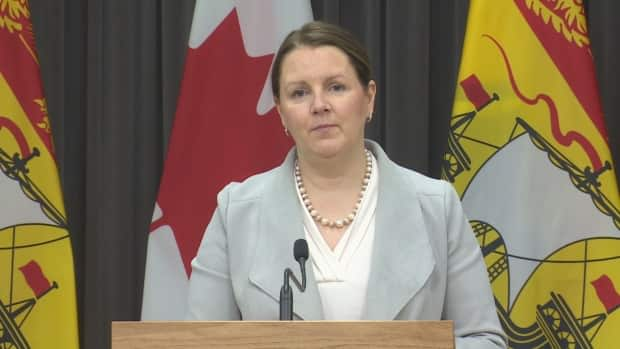Department of Education clarifies Russell's comments about absenteeism triggering school closures

New Brunswick public school will not automatically be closed if their absenteeism rate hits 10 per cent, following the lifting of all COVID-19 restrictions earlier this week, as the province's top doctor indicated, according to the Department of Education.
"When a school hits an absenteeism level of 10 per cent or above their normal attendance levels, this triggers an assessment from Public Health," department spokesperson Flavio Nienow said in an emailed statement.
"Based on that assessment, Public Health could provide direction to close a school or class. Alternatively, they could continue to monitor the situation.
"As such, a school may not necessarily close when the 10 per cent threshold is reached."
On Monday, CBC News asked Dr. Jennifer Russell, the chief medical officer of health, about the government's decision to provide the public with less information to make informed decisions, now that the COVID-19 dashboard is being updated only weekly instead of daily, and parents no longer have to report if their child tests positive for COVID to their school.
"With respect to the schools and the reporting, the shift really is around making sure that we still report information as we do with other transmissible diseases and certainly in the school setting, when the absenteeism reaches 10 per cent, that's when a school would be closed," she said.
"And so that's the approach we're using right now with COVID moving forward. And that's what happened, you know, before COVID with any [other] outbreaks."

In fact, earlier in the pandemic, absenteeism at some schools reached more than 50 per cent.
In January 2021, on the first day a new policy took effect, keeping K-12 schools open at the most restrictive red level, the average absenteeism across two school districts jumped to nearly 25 per cent, while at least two others were well over 10 per cent, although the attendance records indicate only that the students were absent from school, not the reasons why.
Asked if the province will know when a school reaches 10 per cent absenteeism if parents are no longer reporting their children's positive cases, Russell replied, "We hope that people will continue to report.
"It is very important for people to self-report" positive rapid test results, she said.
School attendance data does not specify whether a student is missing class because of COVID, flu or another type of illness, said Nienow.
But Public Health uses absenteeism data from schools to help inform Flu Watch and prevent major outbreaks of communicable diseases such as pertussis, measles and gastroenteritis infections, he said.
"Public Health's assessment takes into account all absence types to evaluate the situation, determine the level of risk and take action if deemed necessary."

In a statement Wednesday, Department of Health spokesperson Gail Harding said Russell "was correct to cite 10 per cent as the minimum threshold for Public Health to intervene in schools as a result of a communicable disease, which in some scenarios, could lead to closures depending on the level of risk, which would be established and informed by an assessment."
But Russell did not say 10 per cent was the "minimum threshold." She said, "when the absenteeism reaches 10 per cent, that's when a school would be closed."
Public Health will continue to work with the Department of Education "on a myriad of ways to manage COVID-19 in schools," continued Harding.
"The virus is not going anywhere, but we are in a position to manage COVID-19 as a communicable disease and to fine-tune what that looks like from sector to sector," she said.
"This is an opportunity for us all to improve the overall health and well-being of New Brunswickers by upkeeping good habits that were ingrained and reinvigorated throughout the pandemic."
Public Health will also continue to assess whether COVID-19 activity in New Brunswick has "exceeded the health-care system's capacity," Harding added.
Absenteeism rates not provided
Nienow did not immediately respond to a request for school absenteeism rates since Monday, when the province lifted all remaining mandatory COVID measures, including isolation for people who test positive and masking.
Of the 12,889 cases of COVID-19 reported at schools since Sept. 7, nearly 9,500 of them were self-reported by parents and staff between Feb. 1 and March 1, while restrictions were still in place, the department's website, which has been discontinued, shows.
More than 14,000 students stayed home from school on Jan. 20, 2021, when new measures took effect, keeping schools in red zones open instead of moving to online learning.
That figure does not include any high school students in two of the anglophone districts because their attendance is recorded on a period-by-period basis. Nor does it include any students at schools in one of the francophone districts, which did not respond to a request for information.
In the Anglophone South School District, absenteeism spiked to 23 per cent, from 14 per cent the previous day. Princess Elizabeth School had the district's highest absenteeism rate that day, at 57 per cent, which was actually down from 67 per cent the day before.
Belleisle Elementary School had the second highest absenteeism rate at 53 per cent, while Millidgeville North School had 40 per cent of students absent, and Quispamsis Middle School, 27 per cent.
In the Anglophone East School District, nearly 23 per cent of its K-8 students were absent.
The absenteeism rate in the Anglophone West School District was 18 per cent.
In the Anglophone North School District, 13 per cent of its K-8 students didn't make it to classes.
The absenteeism rate at schools across the Francophone Northeast School District was around 12 per cent.
The Francophone South School District saw an absenteeism rate of eight per cent.
Francophone Northwest School District did not provide its figures.


